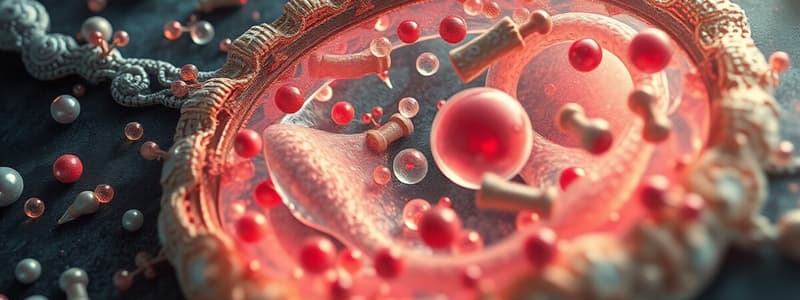Podcast
Questions and Answers
What type of division do mitochondria undergo?
What type of division do mitochondria undergo?
- Budding
- Mitosis
- Fission (correct)
- Meiosis
Which structure is responsible for protein processing and sorting?
Which structure is responsible for protein processing and sorting?
- Lysosome
- Golgi Apparatus (correct)
- Rough Endoplasmic Reticulum
- Nucleus
What is the main function of simple squamous epithelium?
What is the main function of simple squamous epithelium?
- Secretion
- Protection
- Diffusion (correct)
- Absorption
Where is simple cuboidal epithelium primarily located?
Where is simple cuboidal epithelium primarily located?
Which of the following accurately describes transitional epithelium?
Which of the following accurately describes transitional epithelium?
What is the primary function of cilia?
What is the primary function of cilia?
The nucleus contains which of the following structures?
The nucleus contains which of the following structures?
Which epithelium type is found lining the trachea?
Which epithelium type is found lining the trachea?
What is a characteristic of keratinized stratified squamous epithelium?
What is a characteristic of keratinized stratified squamous epithelium?
What type of connective tissue has specialized staining techniques to identify?
What type of connective tissue has specialized staining techniques to identify?
Flashcards
Mitochondria Division
Mitochondria Division
A type of cell division where mitochondria duplicate themselves. This process ensures the necessary energy production for the cell.
Golgi Apparatus Function
Golgi Apparatus Function
A cellular organelle that plays a critical role in processing, packaging, and distributing proteins and lipids. It modifies proteins and sorts them for their final destination.
Endoplasmic Reticulum (RER) Function
Endoplasmic Reticulum (RER) Function
A network of interconnected sacs or tubes that plays a vital role in protein synthesis and the transport of molecules within the cell. It is studded with ribosomes that facilitate the production of proteins.
Lysosome Function
Lysosome Function
Signup and view all the flashcards
Centriole Function
Centriole Function
Signup and view all the flashcards
Cilia Structure & Function
Cilia Structure & Function
Signup and view all the flashcards
Microvilli Structure & Function
Microvilli Structure & Function
Signup and view all the flashcards
Nucleus Function
Nucleus Function
Signup and view all the flashcards
Simple Squamous Epithelium Function & Site
Simple Squamous Epithelium Function & Site
Signup and view all the flashcards
Transitional Epithelium Structure & Function
Transitional Epithelium Structure & Function
Signup and view all the flashcards
Study Notes
Cell Structure and Function
- Cell Membrane Structure: Composed of a phospholipid bilayer with hydrophilic heads and hydrophobic tails. Proteins, glycolipids, and glycoproteins are embedded within the bilayer. The membrane has a dynamic structure and is selectively permeable.
Cellular Components
-
Mitochondria: Organelles with an outer and inner membrane; the inner membrane is folded into cristae, increasing surface area for energy production. The matrix houses the enzymes of the Krebs cycle and the electron transport chain.
-
Golgi Apparatus: A stack of flattened sacs (cisternae). The cis face receives proteins, while the trans face packages and sorts them for transport. Functions in protein modification and packaging.
-
RER (Rough Endoplasmic Reticulum): Network of interconnected membranes with ribosomes attached. Site of protein synthesis and modification, particularly for proteins destined for secretion or insertion into membranes.
-
Lysosomes: Membrane-bound organelles containing digestive enzymes. Primary lysosomes contain undigested material or pathogens; secondary lysosomes contain material that is being digested.
-
Centrioles: Cylindrical structures involved in cell division. Found in pairs, they form the centrosome.
-
Cilia: Hair-like projections from the cell surface, involved in movement of substances across the cell surface. Basal bodies, similar to centrioles, anchor cilia.
-
Microvilli: Finger-like projections of the cell membrane, increasing surface area for absorption. Internal support is provided by actin filaments anchoring them to the cell membrane.
-
Nucleus: Contains the cell's genetic material (DNA) organized into chromosomes. Contains a nucleolus, site of ribosome assembly.
Epithelial Tissues
-
Simple Squamous Epithelium: Single layer of flattened cells; found in lung alveoli and blood capillaries, facilitating diffusion and filtration.
-
Simple Cuboidal Epithelium: Single layer of cube-shaped cells; found in kidney tubules, involved in secretion and absorption.
-
Simple Columnar Epithelium: Single layer of column-shaped cells; found in the digestive tract, involved in absorption and secretion.
-
Pseudostratified Columnar Epithelium: Appears layered but all cells contact the basement membrane; found in the respiratory tract (trachea), involved in secretion and movement of mucus.
-
Stratified Squamous Epithelium (Keratinized): Multiple layers of flattened cells; found in skin, protecting against abrasion.
-
Stratified Squamous Epithelium (Non-Keratinized): Multiple layers of flattened cells; found in oral cavity, moist environment protection.
-
Transitional Epithelium: Cells that can change shape; found in the urinary bladder, accommodating stretching.
Connective Tissues
-
Reticular Connective Tissue: Thin reticular fibers form a supportive network; found in lymph nodes and bone marrow.
-
Mucoid Connective Tissue: Gelatinous matrix; found in umbilical cord.
-
Adipose Connective Tissue: Fat cells (adipocytes); stores energy, provides insulation, and cushioning. White adipose (unilocular) and brown adipose (multilocular).
Blood Cell Types
-
Neutrophils: Granulocytes; phagocytic cells, involved in fighting infections.
-
Eosinophils: Granulocytes; involved in allergic reactions and parasitic infections.
-
Basophils: Granulocytes; release histamine and other mediators in allergic reactions.
-
Lymphocytes: Involved in the specific immune response.
-
Monocytes: Macrophages; phagocytic cells in tissues.
Studying That Suits You
Use AI to generate personalized quizzes and flashcards to suit your learning preferences.




